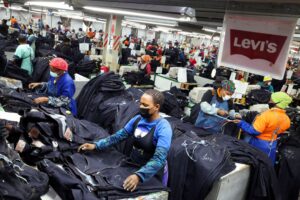<p class="canvas-atom canvas-text Mb(1.0em) Mb(0)–sm Mt(0.8em)–sm" type="text" content="Amazon.com (NASDAQ: AMZN) reported first-quarter results Thursday evening. The company crushed its own profit projections, based on sales near the top end of the official guidance range. Let’s have a closer look at Amazon’s solid report.” data-reactid=”11″>Amazon.com (NASDAQ: AMZN) reported first-quarter results Thursday evening. The company crushed its own profit projections, based on sales near the top end of the official guidance range. Let’s have a closer look at Amazon’s solid report.
By the numbers
<p class="canvas-atom canvas-text Mb(1.0em) Mb(0)–sm Mt(0.8em)–sm" type="text" content="Amazon's net sales rose 17% year over year, landing at $59.7 billion. This was achieved despite a currency exchange headwind of $1.1 billion on the top line — roughly in line with the company's forecast. Back out the currency effects, and Amazon's revenue growth swells to 19%. Management’s guidance range for this metric stretched from $56 billion to $60 billion and the actual result nearly matched the very top of this range.” data-reactid=”13″>Amazon’s net sales rose 17% year over year, landing at $59.7 billion. This was achieved despite a currency exchange headwind of $1.1 billion on the top line — roughly in line with the company’s forecast. Back out the currency effects, and Amazon’s revenue growth swells to 19%. Management’s guidance range for this metric stretched from $56 billion to $60 billion and the actual result nearly matched the very top of this range.
Further down the income statement, Amazon’s management set up a guidance range between $2.3 billion and $3.3 billion for operating income. As a matter of fact, operating profits more than doubled from $1.93 billion to $4.42 billion.
That’s the end of Amazon’s bare-bones guidance figures for this report, but investors do pay close attention to a few other metrics.
- GAAP net income surged 119% above the year-ago period’s, stopping at $3.56 million. Earnings rose 117% to $7.09 per diluted share, based on a stable share count.
- Amazon generated $1.85 billion of cash from operating activities, up from consuming $1.79 billion in the year-ago period. Free cash flow remained negative, as it usually does in the seasonally challenging first quarter, but the cash outflow decreased from $4.52 billion to $875 million. On a trailing-12-month basis, Amazon’s free cash flow more than tripled from $7.3 billion to $23 billion.


Image source: Amazon.
Breaking it down by business segment
North American retail sales rose 17% to $35.8 billion. Operating profits in this segment doubled to $2.29 billion.
International e-commerce revenue increased by 9%, stopping at $16.2 billion. This division tightened up its operating losses from $622 million to $90 million.
The cloud computing services found in the Amazon Web Services (AWS) segment produced net sales of $7.7 billion. That’s a 41% year-over-year boost, driving the division’s operating profits 58% higher to $2.22 billion.
In other words, the bulk of Amazon’s revenue growth came from the AWS division, but the North American e-commerce and Whole Foods operations pulled their weight in terms of profit increases.
Looking ahead
For the second quarter, Amazon provided the following guidance ranges:
- Net sales should land between $59.5 billion and $63.5 billion, which amounts to a 17% year-over-year increase at the midpoint. This target includes a softer currency exchange headwind, slowing down from 1.8% in the first quarter to approximately 1.5% in the current period.
- Operating income could come in as low as $2.6 billion or as high as $3.6 billion. At the midpoint, that’s fairly comparable to the year-ago quarter’s $3 billion result.
- Work the math on these guidance targets and you’ll see that Amazon’s operating margin should stop somewhere between 4.1% and 6.1%. That would be down from 7.4% in Q1 and mostly below the 5.6% margin that was recorded in the second quarter of 2018.


This growing fleet will put some pressure on Amazon’s margins in the second quarter. Image source: Amazon.
What management said
<p class="canvas-atom canvas-text Mb(1.0em) Mb(0)–sm Mt(0.8em)–sm" type="text" content="On the earnings call, CFO Brian Olsavsky provided some commentary on why the second-quarter profit margins are trending lower. It’s all about rising costs related to upgrades in the Amazon Prime shipping program:” data-reactid=”55″>On the earnings call, CFO Brian Olsavsky provided some commentary on why the second-quarter profit margins are trending lower. It’s all about rising costs related to upgrades in the Amazon Prime shipping program:
We’re currently working on evolving our Prime free two-day shipping program to be a free one-day shipping program. We’re able to do this because we’ve spent 20-plus years expanding our fulfillment and logistics network, but this is still a big investment and a lot of work to do ahead of us. For Q2 guidance, we’ve included approximately $800 million of incremental spend related to this investment.
And just to clarify, we have been offering obviously faster than two-day shipping for Prime members for years. One-day, same-day, even down to one- to two-hour delivery for Prime Now. So we’re going to continue to do to offer same-day and Prime Now selection on accelerated basis, but this is all about the core free two-day offer evolving into a free one-day offer. We’ve already started down this path.
The company has already started these improvements, expanding both the service area and the items eligible for one-day shipping during the first quarter. There’s simply a lot more work left to do.
“It’s a significant step and it will take us time to achieve and we want to ensure that we have a good delivery experience for our customers as we evolve the software,” Olsavsky said.
<p class="canvas-atom canvas-text Mb(1.0em) Mb(0)–sm Mt(0.8em)–sm" type="text" content=" More From The Motley Fool ” data-reactid=”64″> More From The Motley Fool
<p class="canvas-atom canvas-text Mb(1.0em) Mb(0)–sm Mt(0.8em)–sm" type="text" content="John Mackey, CEO of Whole Foods Market, an Amazon subsidiary, is a member of The Motley Fool’s board of directors. Anders Bylund owns shares of Amazon. The Motley Fool owns shares of and recommends Amazon. The Motley Fool has a disclosure policy.” data-reactid=”72″>John Mackey, CEO of Whole Foods Market, an Amazon subsidiary, is a member of The Motley Fool’s board of directors. Anders Bylund owns shares of Amazon. The Motley Fool owns shares of and recommends Amazon. The Motley Fool has a disclosure policy.




